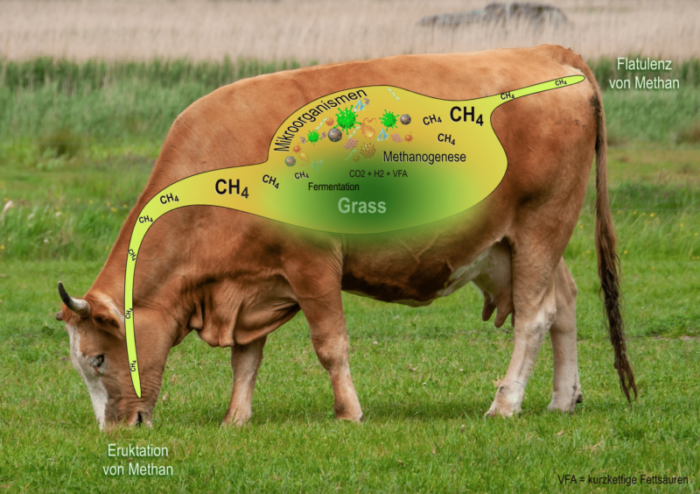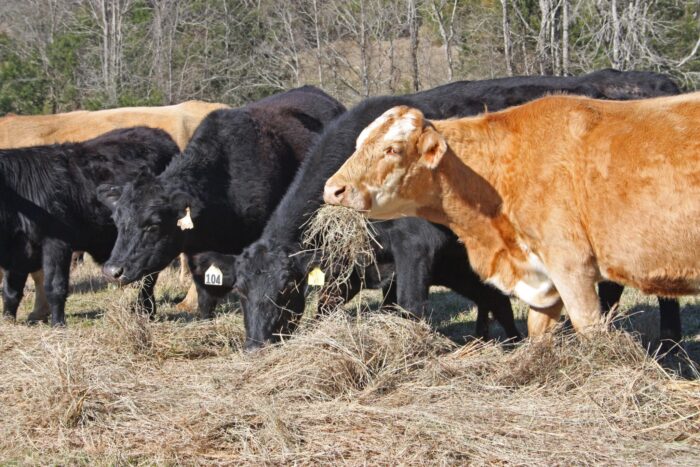
Reducing Methane “Hoofprints” – A Farmer’s Guide to Lowering Agricultural Methane Production
May 24, 2023By Aarushi Ammavajjala, 2023 Future Blue Youth Council member
Featured Image: “Fart Effect” by Chaepin Kim (Los Angeles, CA)
Globally, cows emit as much greenhouse gas as one billion small cars. However, these gases aren’t all carbon dioxide. The digestive system of cattle is one of the major sources of the second-most destructive greenhouse gas: methane.
Throughout a 20-year period, methane traps 80 times more heat than carbon dioxide. A 45% reduction in total methane emissions in the next decade would prevent 260,000 premature human deaths, 775,000 respiratory-linked visits to the hospital, 73 billion hours of labor lost due to extreme heat, and 25 million tons of crops lost. Reducing methane emissions is completely feasible, with effective and rapid climate action.
In the quest to stave off the 1.5-degree Celsius threshold that scientists say is critical to avoiding the worst impacts of the climate crisis, policies targeting methane emissions have been unrightfully neglected.
The good news? Congress recently passed a bill, the Methane Emissions Reduction Act of 2021, that hits natural gas giants with fees (about $1,800 per ton of methane released). The bad news? Only 35% of human-derived methane comes from the energy sector. Agriculture is responsible for another 40% of human-induced methane.
Globally, cows release as much or more greenhouse gas as the entire European Union. Why are cattle such big contributors? It all has to do with what and how they eat.

Hannes Grobe, Matti Blume: Foto der Kuh, CC BY-SA 4.0, via Wikimedia Commons
Cows (and some other livestock) have four compartments in their stomachs – the abomasum, omasum, reticulum, and rumen – which help them digest grass and other high-fiber vegetation. The rumen stores partially digested food that is processed by protists, bacteria, and archaea through enteric fermentation. The food will later travel back up to the cow’s mouth, where it’ll be chewed and digested once more. This process releases enormous amounts of carbon dioxide and hydrogen—used by methanogens (methane-producing bacteria) in the cow’s digestive system in order to create and release methane. This fermentation process in the rumen, which allows cattle to digest food that humans cannot, is why cows release so much methane.
Obviously, we can’t stop cattle from having rumen, but we can change what goes into it. Three financially friendly solutions and feed additives farmers can implement to reduce methane emissions are nitrate, dietary fat, and Mootral.
Nitrates are a feed additive solution that can significantly reduce methane emissions from cattle by up to 30%. Nitrates increase food-to-energy conversion efficiency and act as an alternative source of energy for cattle. This leads to a reduction in feed costs and in the production of methane. Cattle are able to convert more of the feed it consumes into usable energy, leading to weight gain and improved productivity. Nitrates have become an important solution because we can reduce methane without impacting farmers’ profits.
Another solution to reducing methane emissions in cattle is through the use of dietary fat. Adding fat to the cattle’s diet has been shown to reduce methane emissions by up to 20%. Dietary fat decreases the availability of hydrogen in the cow’s gut, which is necessary for methane production. It can also improve cattle’s health, productivity, and performance.

Alabama Extension, CC0, via Wikimedia Commons
Both of these supplements, nitrates and dietary fat, are currently commercially available, and approved solutions under the Australian Emissions Reduction Fund. However, innovations in this field have led to a new, promising feed additive tailored for farmers, considering price point, animal health, product quality, and much more: Mootral.
Mootral is a natural supplement made of garlic and citric acid. It has been shown to significantly reduce methane emissions in cows, with up to 38% reduction in vivo and almost complete inhibition in the lab. That’s the equivalent of removing 300 million cars from the roads! Mootral does not impact animal health or the quality of animal products—it actually provides a 3-5% increase in milk yield. Mootral is affordable, at a cost of around $0.14 to $0.16 USD per cow per day, to reduce greenhouse gas and methane emissions from ruminant animals.
A huge problem in the fight against climate change is the livestock industry, which is responsible for a considerable portion of world methane emissions and thus, climate change. Agricultural industries must consider their climate impact as the demand for dairy and meat products grows every day. By starting small, starting with the farmer, and implementing these solutions, we can all continue to work towards making agriculture carbon-Mootral!
